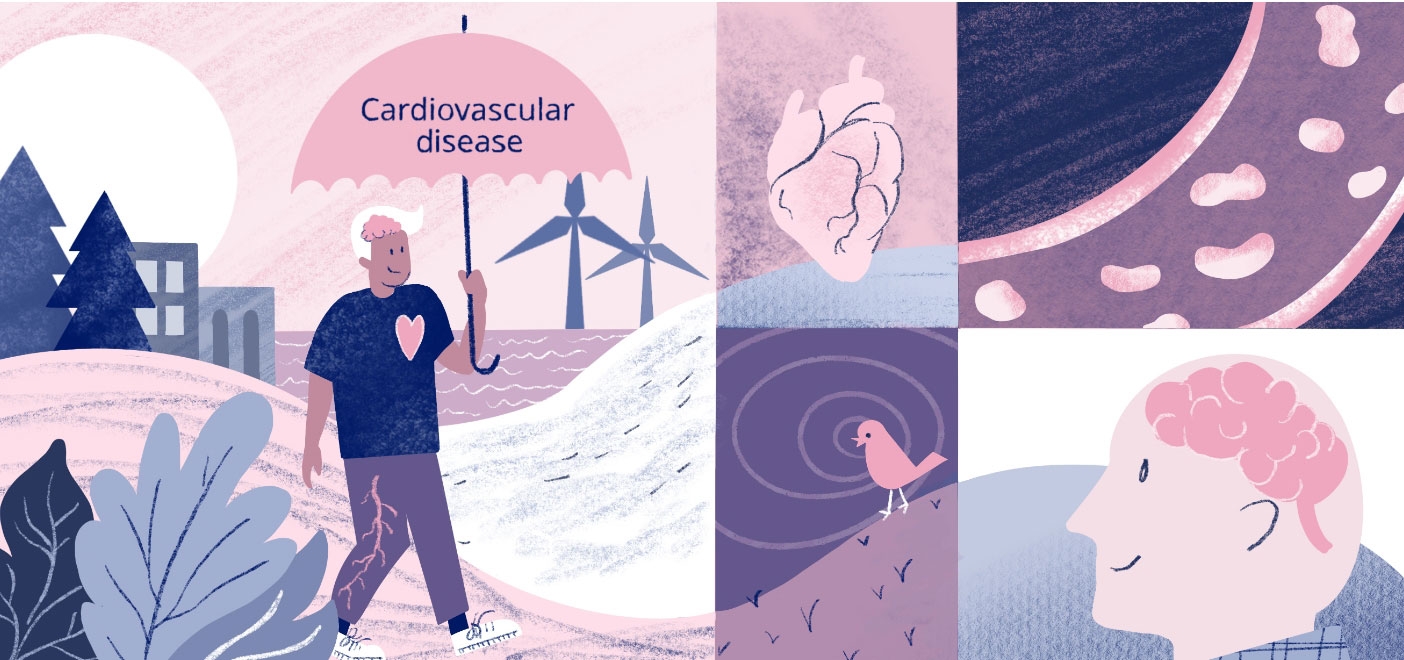
Cardiovascular disease refers to a group of conditions affecting the heart and blood vessels.1 This includes coronary heart disease, cerebrovascular disease, peripheral arterial disease and aortic disease.1,2 Many forms of cardiovascular disease develop due to the build-up of fatty deposits within the arteries, a process known as atherosclerosis.1 Over time, this process can cause the arteries to become narrower, which in some instances can lead to a heart attack or stroke.3
In the UK, more than 7.6 million people (over 4 million males and 3.6 million females) are living with cardiovascular disease — that’s around double the amount of people who are living with cancer and Alzheimer’s disease combined.4
Risk factors for developing cardiovascular disease include high blood pressure, high cholesterol, smoking, obesity, physical inactivity and diabetes.5
- Coronary heart disease (CHD):6 CHD occurs when the arteries that supply oxygen-rich blood to the heart become narrowed or blocked due to the build-up of fatty substances. This reduces blood flow to the heart, which can lead to chest pain (angina) or more severe conditions, like heart attacks, if blood flow is completely blocked. Lifestyle factors such as smoking, an unbalanced diet and lack of exercise, along with conditions like high blood pressure, diabetes and high cholesterol, increase the risk of developing CHD.
- Cerebrovascular disease:7,8 Cerebrovascular disease refers to conditions affecting the blood vessels in the brain. The most common type of cerebrovascular disease is stroke, which occurs when blood flow to a part of the brain is interrupted, either by a blockage (ischemic stroke) or a burst blood vessel (haemorrhagic stroke). High blood pressure, high cholesterol, age, family history and having diabetes are key risk factors for the condition.
- Peripheral artery disease (PAD):9,10 PAD occurs when the arteries that supply parts of the body other than the heart or brain become narrowed due to a build-up of fatty deposits, reducing blood flow. It most commonly affects the arteries leading to the legs and lower body, causing leg pain during walking. This symptom, known as intermittent claudication, usually improves with rest. In more severe cases, PAD can lead to persistent pain, ulcers, and even tissue death (gangrene) if blood flow is not restored. Risk factors for PAD include smoking, diabetes and high blood pressure. Older adults are more likely to develop the condition, with about one in five people over the age of 60 affected in the UK.
- Aortic disease:1,11 Aortic disease affects the aorta, the largest blood vessel in the body that carries oxygen-rich blood from the heart to the rest of the body. Diseases of the aorta can be very serious and potentially life-threatening. One of the most common aortic diseases is aortic aneurysm, a condition where the aorta becomes weakened and bulges outwards. Risk factors for developing an aortic aneurysm include increasing age, high blood pressure, smoking and atherosclerosis.
NHS UK. Cardiovascular disease; 22 April 2022. Available from: https://www.nhs.uk/conditions/cardiovascular-disease/ [Accessed August 2025]
Lopez EO et al. Cardiovascular disease; 22 August 2023. Available from: https://www.ncbi.nlm.nih.gov/books/NBK535419/ [Accessed August 2025]
NHS UK. Atherosclerosis; 30 January 2023. Available from: https://www.nhs.uk/conditions/atherosclerosis/ [Accessed August 2025]
British Heart Foundation. UK factsheet; January 2025. Available from: https://www.bhf.org.uk/-/media/files/for-professionals/research/heart-statistics/bhf-cvd-statistics-uk-factsheet.pdf [Accessed August 2025]
Heart Research Institute UK. Risk factors for cardiovascular disease. Available from: https://www.hriuk.org/health/learn/risk-factors/risk-factors-for-cardiovascular-disease [Accessed August 2025]
NHS UK. Coronary heart disease; 17 January 2024. Available from: https://www.nhs.uk/conditions/coronary-heart-disease/ [Accessed August 2025]
British Heart Foundation. Protecting the brain: Impact of British Heart Foundation support for cerebrovascular research; July 2024. Available from: https://www.bhf.org.uk/-/media/files/what-we-do/impact-reviews-2023/cerebrovascular-impact-thematic-review-2024.pdf [Accessed August 2025]
British Heart Foundation. Stroke – causes, signs and symptoms; 1 February 2024. Available from: https://www.bhf.org.uk/informationsupport/conditions/stroke [Accessed August 2025]
British Heart Foundation. Peripheral artery disease research. Available from: https://www.bhf.org.uk/what-we-do/our-research/circulatory-conditions-research/peripheral-artery-disease-research [Accessed August 2025]
British Heart Foundation. Focus on: Peripheral arterial disease; 15 August 2014. Available from: https://www.bhf.org.uk/informationsupport/heart-matters-magazine/medical/peripheral-arterial-disease [Accessed August 2025]
British Heart Foundation. Aortic aneurysm, dissection and rupture; 1 September 2022. Available from: https://www.bhf.org.uk/informationsupport/conditions/aortic-aneurysm-dissection-and-rupture [Accessed August 2025]
National Institute for Health and Care Excellence (NICE). What is the impact of CVD?; July 2025. Available from: https://cks.nice.org.uk/topics/cvd-risk-assessment-management/background-information/burden-of-cvd/ [Accessed August 2025]